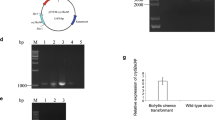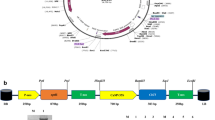Summary
The insecticidal effectiveness of a δ-endotoxin Cry protein from Bacillus thuringiensis in non-regenerable callus of a commercial Gossypium hirsutum L. variety was investigated. Two transgenic callus types were generated. The first callus type harbored the cry1A(c) gene and the hygromycin B phosphotransferase hpt selectable marker gene. The second callus type, the transgenic control, carried the marker genes β-glucuronidase (GUS) and hpt. Growth and survival rates of three major cotton moth species, Pectinophora gossypiella, Helicoverpa armigera, and Spodoptera littoralis, were examined with aseptic neonates reared on callus. Normal larval development occurred in all species supplied with non-transgenic callus, but insects died, or their growth was severely restricted, when reared on transgenic callus harvested from hygromycin B-supplemented medium. Development of larvae on transgenic control and on non-transgenic callus became very much alike after the transgenic control tissue had been subcultured on a hygromyein B-free medium for about 100 d prior to the insect-callus bioassay. Accordingly, for detection of Bt toxin activity without the interference of the influence of hygromycin B on insects, cry1A(c) callus was infested with insects after it had been propagated for more than 100 d on a medium free of the antibiotic. Under these experimental conditions all P. gossypiella and H. armigera, and most S. littoralis neonates died, and the growth (e.g., weight increment) of S. littoralis survivors was markedly impeded by cry1A(c) callus. Three new findings emerge from this study: first, P. gossypiella, a pest feeding in the field on bolls only, can be grown in vitro on cotton callus; second, in a host which is recalcitrant in terms of plant regeneration, the biological potency of an insectdetrimental transgene can nevertheless be evaluated by generating a transgenic host callus and conducting in vitro transgenic callus-insect assays; and third, our results suggest that hygromycin B is toxic to lepidopteran larvae.
Similar content being viewed by others
References
Armstrong, C. L.; Parker, G. B.; Pershing, J. C.; Brown, S. M.; Sanders, P. R.; Duncan, D. R.; Stone, T.; Dean, D. A.; DeBoer, D. L.; Hart, J.; Howe, A. R.; Morrish, F. M.; Pajeau, M. E.; Petersen, W. L.; Reich, B. J.; Rodriguez, R.; Santino, C. G.; Sato, S. J.; Schuler, W.; Sims, S. R.; Stehling, S.; Tarochione, L. J.; Fromm, M. E. Field evaluation of European corn borer control in progeny of 173 transgenic corn events expressing an insecticidal protein from Bacillus thuringiensis. Crop Sci. 35:550–557; 1995.
Cheng, Z. M.; Schmurr, J. A.; Kapaun, J. A. Timentin as an alternative antibiotic for suppression of Agrobacterium tumefaciens in genetic transformation. Plant Cell Rep. 17:646–649; 1998.
Costa, M. G. C.; Nogueira, F. T. S.; Figueira, M. L.; Otoni, W. C.; Brommonschenkel, S. H.; Cecon, P. R. Influence of the antibiotic timentin on plant regeneration of tomato (Lycopersicon esculentum Mill.) cultivars. Plant Cell Rep. 19:327–332; 2000.
Courtney, C. H.; Roberson, E. L. Antinematodal drugs. In: Adams, H. R., ed. Veterinary pharmacology and therapeutics, Ames: Iowa State University Press; 1995:927–928.
den Dulk-Ras, A.; Hooykaas, P. J. Electroporation of Agrobacterium tumefaciens. Methods Mol. Biol. 55:63–72; 1995.
Dowd, P. F.; Norton, R. A. Browning-associated mechanism of resistance to insects in corn callus. J. Chem. Ecol. 21:583–600; 1995.
Eustice, D. C.; Wilhelm, J. M. Mechanisms of action of aminoglycoside antibioties in eucaryotic protein synthesis. Antimicrob. Agents Chemother. 26:53–60; 1984.
Gamborg, O. L.; Miller, R. A.; Ojima, K. Nutrient requirement of suspension cultures of soybean root cells. Exp. Cell. Res. 50:151–158; 1968.
González, A.; Jiménez, A.; Vázquez, D.; Davies, J. E.; Schindler, D. Studies on the mode of action of hygromycin B, an inhibitor of translocation in eukaryotes. Biochim. Biophys. Acta 521:450–469; 1978.
Hood, E. E.; Gelvin, S. B.; Melchers, L. S.; Hoekama, A. New Agrobacterium helper plasmid for gene transfer to plants. Transgenic Res. 2:208–218; 1993.
Kumar, S.; Sharma, P.; Pental, D. A genetic approach to in vitro regeneration of non regenerating cotton (Gossypium hirsutum L.) cultivars source. Plant Cell Rep. 18:59–63; 1998.
Manuvakhova, M.; Keeling, K.; Bedwell, D. M. Aminoglycoside antibioties mediate context-dependent suppression of termination codons in a mammalian translation system. RNA 6:1044–1055; 2000.
Matsubara, T.; Beeman, R. W.; Shike, H.; Besansky, N. J.; Mukabayire, O.; Higgs, S.; James, A. A.; Burns, J. C. Pantropic retroviral vectors integrate and express in cells of the malaria mosquito, Anopheles gambiae. Proc. Natl. Acad. Sci. USA 93:6181–6185; 1996.
Murashige, T.; Skoog, F. A revised medium for rapid growth and bioassays with tobacco tissue cultures. Physiol. Plant. 15:473–497; 1962.
Navon, A.; Klein, M.; Braun, S. Bacillus thuringiensis potency bioassay against Heliothis armigera, Earias insulana, and Spodoptera littorallis larvae based on standartized diets. J. Invertebr. Pathol. 55:387–393; 1990.
Pechan, T.; Ye, L.; Chang, Y.; Mitra, A.; Lin, L.; Davis, F. M.; Williams, W. P.; Luthe, D. S. A unique 33-kD cysteine proteinase accumulates in response to larval feeding in maize genotypes resistant to fall armyworm and other lepidoptera. Plant Cell 12:1031–1040; 2000.
Shorey, H. H.; Hale, R. L. Mass rearing of larvae of nine Noctuid species on a simplified medium. J. Econ. Entomol. 58:522–524; 1965.
Sjölander, K. B.; Golovljova, I.; Plyusnin, A.; Lundkvist, Å. Diagnostic potential of pluumala virus nucleocapsid protein expression in Drosophila melanogaster cells. J. Clinic. Microbiol. 38:2324–2329; 2000.
Steinitz, B.; Navon, A.; Berlinger, M. J.; Klein, M. Expression of insect resistance in in vitro-derived callus tissue infested with Lepidopteran larvae. J. Plant Physiol. 142:480–484; 1993.
Steinitz, B.; Navon, A.; Berlinger, M. J.; Mazor, M. Carbohydrates supplements to the callus culture medium modify the growth of potato tuber moth larvae feeding on Lycopersicon chmielewskii callus. Physiol. Plant. 101:556–562; 1997.
Tang, H.; Ren, Z.; Krezal, G. An evaluation of antibiotics for the elimination of Agrobacterium tumefaciens from walnut somatic embryos and for the effect on the proliferation of somatic embryos and regeneration of transgenic plants. Plant Cell Rep. 109:881–887; 2000.
Trolinder, N. L.; Xhixian, C. Genotype specificity of the somatic embryogenesis response in cotton. Plant Cell Rep. 8:133–136; 1989.
van den Elzen, P. J. M.; Townsend, J.; Lee, K. Y.; Bedbrook, J. R. A chimeric hygromycin resistance gene as a selectable marker in plant cells. Plant Mol. Biol. 5:299–302; 1985.
Van Wordragen, M. F.; Honée, G.; Dons H. J. M. Insect-resistant chrysauthemum calluses by introduction of Bacillus thuringiensis crystal protein gene. Transgenic Res. 2:170–180; 1993.
Vulsteke, V.; Janssen, I.; Broeck, J. Vanden; De Loof, A.; Huybrechts, R. Baculovirus immediate early gene promoter based expression vectors for transient and stable transformation of insect cells. Insect Mol. Biol. 2:195–204; 1993.
Waldron, C.; Murphy, E. B.; Roberts, J. L.; Gustafson, G. D.; Armour, S. L.; Malcolm, S. K. Hesistance to hygromyein B: a new marker for plant transformation studies. Plant Mol. Biol. 5:103–108; 1985.
Wilkins, T. A.; Rajasekaran, K.; Anderson, D. M. Cotton biotechnology. Crit. Rev. Plant Sci. 19:511–550; 2000.
Williams, W. P.; Bukely, P. M.; Davis, F. M. Tissue culture and its use in investigations of insect resistance in maize. Agric. Ecosyst. Environ. 18:185–190; 1987.
Zhang, H. B.; Feng, R.; Liu, F.; Wang, Q. High frequency somatic embryogenesis and plant regeneration of an elite Chinese cotton variety. Bot. Bull. Acad. Sin 42:9–16; 2001.
Zhao, Y. G.; Eggleston, P.; Zhao, Y. G. Stable transformation of an Anopheles gambiae cell line mediated by the Hermes mobile genetic element. Insect Biochem. Mol. Biol. 28:213–219; 1998.
Author information
Authors and Affiliations
Corresponding author
Rights and permissions
About this article
Cite this article
Steinitz, B., Gafni, Y., Cohen, Y. et al. Insecticidal activity of a cryia(c) transgene in callus derived from regeneration-recalcitrant cotton (Gossypium hirsutum L.). In Vitro Cell.Dev.Biol.-Plant 38, 247–251 (2002). https://doi.org/10.1079/IVP2001288
Received:
Accepted:
Issue Date:
DOI: https://doi.org/10.1079/IVP2001288




